

Asia’s supply chain: Implications for rebalancing. Persistent global imbalances are raising concerns about the sustainability of the global recovery and longer-term growth.
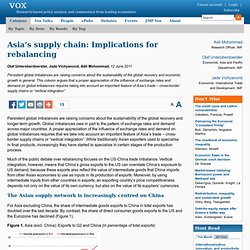
Global imbalances owe in part to the pattern of exchange rates and demand across major countries. A proper appreciation of the influence of exchange rates and demand on global imbalances requires that we take into account an important feature of Asia’s trade – cross-border supply chains or “vertical integration”. While traditionally Asian exporters used to specialise in final products, increasingly they have started to specialise in certain stages of the production process. Much of the public debate over rebalancing focuses on the US-China trade imbalance. Vertical integration, however, means that China’s gross exports to the US can overstate China’s exposure to US demand, because these exports also reflect the value of intermediate goods that China imports from other Asian economies to use as inputs in its production of exports.
Figure 1. Figure 2. Thorbecke. Enterprise Resilience Management Blog: Supply Chain Evolution and Transformation. In a post entitled On the Bandwagon: Supply Chain Orchestration, among other discussed topics was Gartner's Four-Stage Maturity Model.

Where in the world could revolution strike next? Not your average convenience store - Video - Small Business. Raul Ojeda started shining shoes at the age of 18.

A decade later, with the help of his mentor, Willie, he owns his own small business. Goya says it became the U.S.'s biggest Hispanic-owned food company by catering to the tastes of varied Latin-American groups. The manufacturer of pianos has passed the skills of making the musical instrument generation after generation for over 150 years. Defining the Supply Chain. A senior IBM consultant who anonymously writes the blog @ Supply Chain Management, recently wrote a post that asks: What is the Supply Chain?

[10 January 2011] The author decided that this is an intriguing question because it is so difficult to answer. The IBMer writes: "Do you know that this is the most frequently searched Google phrase that drives people to my site (and I'm sure very many other sites in this space as well)? Ah, this is easy enough to answer and so I posed the question to myself: What exactly is the Supply Chain?
I must confess that I really couldn't come up with an answer that didn't suffer from some rebuttal or the other. David Blanchard, in his book entitled Supply Chain Management: Best Practices, asks the same question. "What exactly is a supply chain? Cute story, you say, but it gets us no closer to answering the question at hand; but, in a way its does. That's a pretty good description.
More on Social Media and the Supply Chain. In a post entitled Social Media and the Supply Chain, I examined the views of a number of analysts who concluded that the future belongs to social commerce.
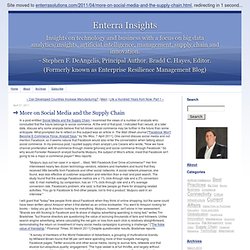
At the end of that post, I indicated that I would, at a later date, discuss why some analysts believe that full-blown social commerce may be further in the future than some anticipate. What prompted me to reflect on this subject was an article in The Wall Street Journal ["Facebook Won't Become E-Commerce Force, Analyst Says," by Stu Woo, 7 April 2011]. One cannot discuss social media and not mention Facebook; so it seems natural that Facebook would also enter the conversation when talking about social commerce. In my previous post, I quoted supply chain analyst Lora Cecere who wrote, "Now we have channel proliferation with M-commerce through mobile [phones] and social commerce through Facebook. " "Mulpuru lays out her case in a report ... titled, 'Will Facebook Ever Drive eCommerce?
' Thinking Twice About Supply-Chain Layoffs. It's the most wonderful time of the year—or that's how the song goes.

But this year's decline in retail sales has resulted in definitely uncheery employee layoffs and payroll cuts, a trend that is likely to continue. While the vicious cycle of declining sales and layoffs is to some degree unavoidable, research by HBS assistant professor Zeynep Ton suggests that retailers should make labor decisions thoughtfully. “Many retailers see labor more as a cost driver than a sales driver.” Her advice: Consider the supply-chain foot soldiers—stock clerks, trucking coordinators, inventory managers—as potential profit drivers rather than the first troops to cut in a downturn. Ton's working paper, "The Effect of Labor on Profitability: The Role of Quality" [PDF], examines how mundane activities such as stocking shelves, setting up displays, labeling, and returning unsold merchandise to distribution centers can seriously affect an organization's bottom line and undermine its strategy.
Global imbalances and the paradox of thrift. People critical of global imbalances often blame the surplus countries and their currency manipulation.
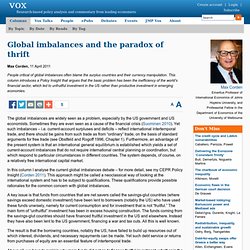
This column introduces a Policy Insight that argues that the basic problem has been the inefficiency of the world’s financial sector, which led to unfruitful investment in the US rather than productive investment in emerging economies. The global imbalances are widely seen as a problem, especially by the US government and US economists. Sometimes they are even seen as a cause of the financial crisis (Suominen 2010).
Yet such imbalances – i.e. current-account surpluses and deficits – reflect international intertemporal trade, and there should be gains from such trade as from “ordinary” trade, on the basis of standard arguments for free trade (see Obstfeld and Rogoff 1996, Chapter 1). Comment / Analysis - Industry left high and dry. Rethink over global supply chain strategy. The Users are the Suppliers. Very clear argument, reproduced in full, from Israel internet activist Hanan Cohen : “I want to suggest that for Facebook, Google, Twitter and companies like them, the users are the suppliers.
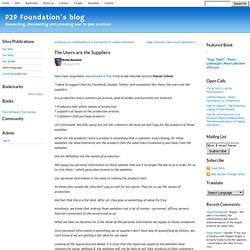
In a production and a commercial process, several bodies and elements are involved: The Ecology of Supply Chains. Supply Webs: Beyond the Supply Chain. Wednesday There is an excellent story in today’s Financial Times by Peter Marsh, High and Dry, about supply chain lessons learned from the disruption following the Sendai earthquake and tsunami in Japan.
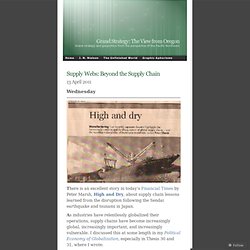
As industries have relentlessly globalized their operations, supply chains have become increasingly global, increasingly important, and increasingly vulnerable. I discussed this at some length in my Political Economy of Globalization, especially in Thesis 30 and 31, where I wrote: “The static model of globalization derived from a completed extrapolation of production geographically distributed according to comparative advantage and lowest opportunity cost is inherently unsustainable and would collapse spectacularly if it could be brought into being. But precisely because it is so vulnerable, it would never come to pass.”